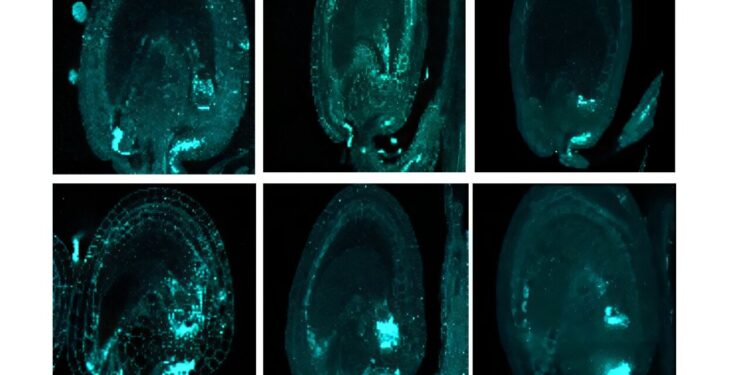The call deposit is reduced from A to C but increased by D to E. (A – C) Wild type ovules in 1 day after pollination (DAP) (A), 2 DAP (B) and 3 DAP (C). (D – f) Geules genetically modified to 1 DAP (D), 2 DAP (E) and 3 DAP (F). Credit: Ryushiro Kasahara
A research group led by Nagoya University in Japan has discovered a new fabric in plants essential to the formation of seeds. Their discovery represents the first new vegetable tissue discovered in 160 years. Their results are opening a new area for research and have already demonstrated practical applications, the team increasing significant crop yields, including rice. The newspaper Current biology published the study.
Since 2005, scientists have known that fertilization is necessary for the body of seeds, known as hypocotyle, receives the nutrients of the “mother” parts of the plant. It is important to understand how plants detect successful fertilization to maximize yields of culture species during farming.
The research group led by Ryushiro Kasahara and Michitaka Nodaguchi discovered the new fabric by chance. Kasahara had stained seeds to follow the deposit of callosis, a waxy substance commonly studied due to his association with fertilization, to verify the results of a previous study.
While examining the stained areas, Kasahara noticed something unexpected. “Plants fertilize by the insertion of a pollen tube, so that most scientists are only interested in the place where this happens. However, we have also found signals on the other side,” he said. “No one was looking at where I was looking for. I remember being surprised, especially when we realized that this signal was particularly strong when fertilization failed.”
A more in -depth analysis has revealed a tissue structure in the shape of a distinctive rabbit which works as a bridge. This structure, called “Kasahara Gateway” in honor of its discoverer, represents the first new plant tissue identified since the middle of the 19th century.
The signal that Kasahara observed results from the callose deposit, which blocks the flow of nutrients and hormones in non -fertilized seeds. The closure of the bridges led the seeds not to receive nutrients and to die. The researchers described this as “the closed state”. On the other hand, when fertilization occurs, hypocotyle detects this success and dissolves the call, allowing nutrients to flow into the seed and allow growth. The researchers called this “openly open”.
“When the flow of nutrients was compared between the fertilized and successful embryos, it was found that the influx of nutrients was only observed in the successful embryos, when it was completely blocked in the unsuccessful,” said Kasahara. “This limits the quantity of resources wasted on non -viable seeds.”
Detailed structure of the ovum multifunctional EP. Credit: Current biology (2025). DOI: 10.1016 / J.Cub.2025.03.033
The capacity of the gateway to be changed between open and closed states has suggested genetic regulation. Researchers have examined fertilized plant hypocotyles to identify potential genetic controls.
They identified a gene called ATBG_PPAP which was regulated on the rise exclusively in fertilized hypocotyles and identified its role in the dissolution of Callose. When they modified the hypocotyles to overexpress ATBG_PPAP, the gateway remained permanently in the open door state, increasing the absorption of nutrients.
“This led us to realize that the continuous gateway could widen the seeds,” said Kasahara. “When we tested this theory with rice seeds, we made seeds that were 9% larger. With seeds from other species, we managed to increase up to 16.5%.”
Their results represent a significant increase in the improvement of seeds in plant farming. Maintaining a permanent open state could considerably increase the yields of significant crops.
Kasahara also believes that these results will improve the understanding of the evolution of plants, in particular why flowering plants (angiosperms) dominate today’s flora.
“Since a non-fertilized hypocotyl cannot become a seed in the first place, feeding it would be” a waste “for the plant,” he said. “Consequently, angiosperms may have been able to survive until modern times by nourishing the body of embryos using this mechanism to ensure that they only give resources to fertilized seeds.”
More information:
Xiaoyan Liu et al, the end of the phloem depending on fertilization regulates the size of the seeds, Current biology (2025). DOI: 10.1016 / J.Cub.2025.03.033
Supplied by Nagoya University
Quote: The first new plant fabric discovered in 160 years increases crop yields (2025, April 10) recovered on April 11, 2025 from
This document is subject to copyright. In addition to any fair program for private or research purposes, no part can be reproduced without written authorization. The content is provided only for information purposes.



